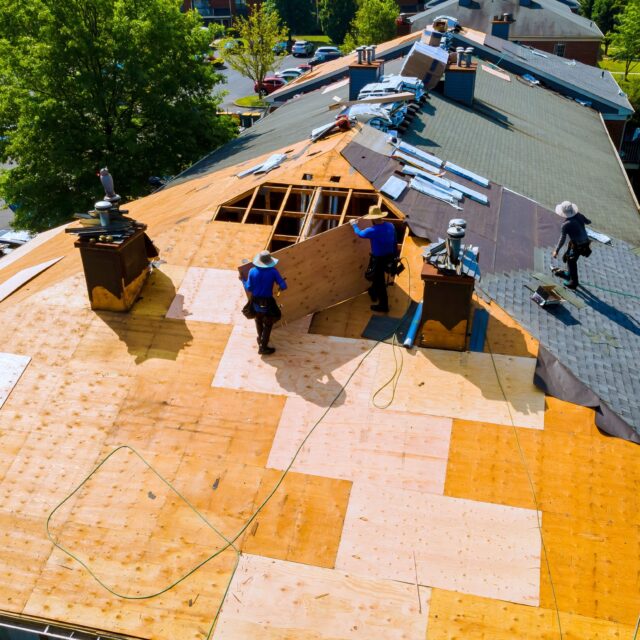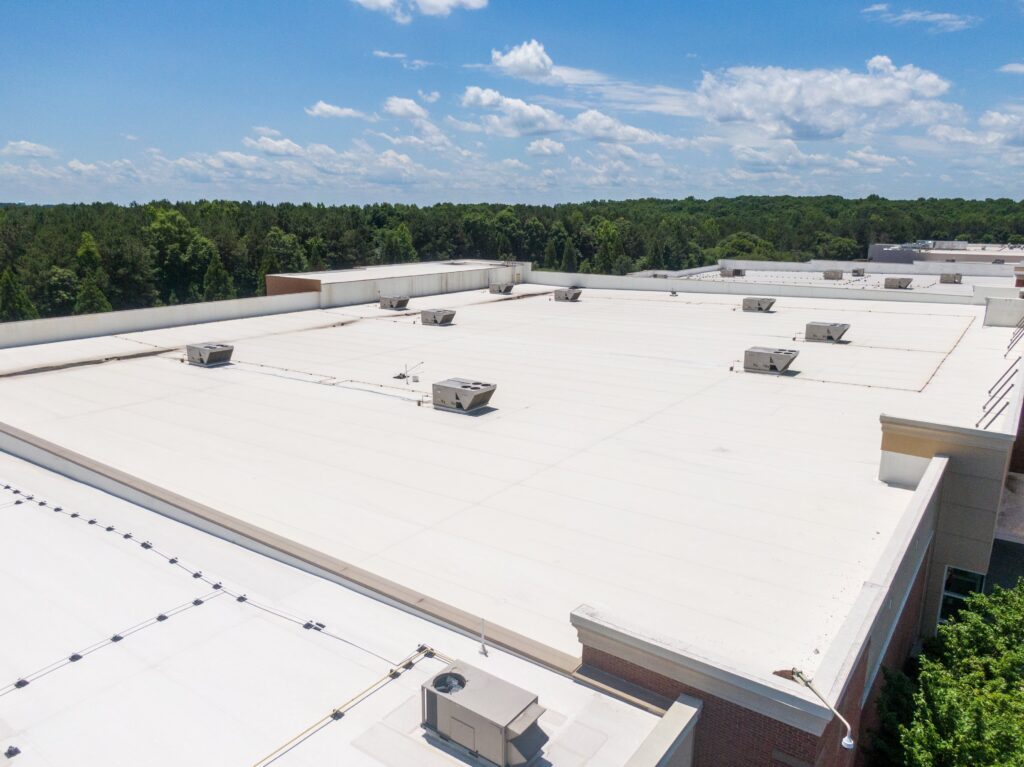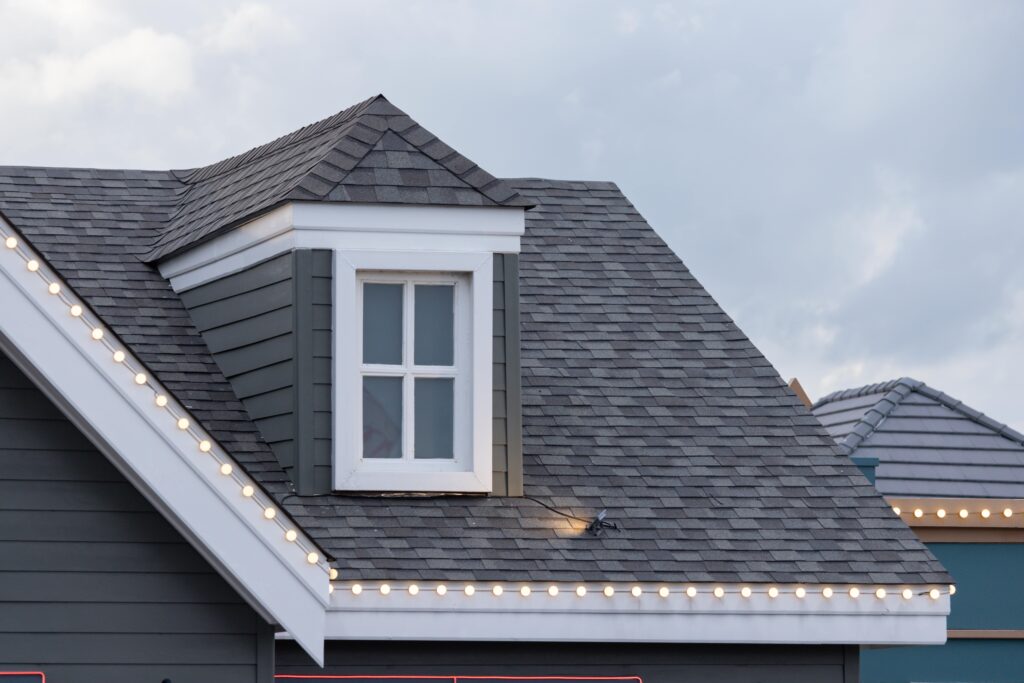What to Know About Residential vs. Commercial Roofing

- Written by: jlbmdev

Roofs, while often overlooked, are crucial components of any building. Whether it’s a cozy home or a busy commercial space, a roof protects from the elements and significantly impacts the overall structure. But is there a big difference between residential vs. commercial roofing? Let’s find out.
Commercial roofs are designed for buildings used for business purposes, such as retail stores, offices, warehouses, and factories. These roofs typically have a flat or low-pitched profile, in contrast to the steeper slopes often seen on residential roofs.
Commercial roofs are significantly larger than residential ones, often spanning millions of square feet. Their primary function is to shield the building and its contents from the elements, ensuring structural integrity, and protecting valuable assets.
Residential roofing refers to the covering of structures designed for human habitation, such as houses and apartments. These roofs are generally smaller in scale and have a steeper pitch compared to commercial roofs, often contributing to the overall aesthetic appeal of the building.
Residential roofs can be constructed from a variety of materials and may feature different structural designs, such as single-pitch, double-pitch, or trussed roofs.
While residential and commercial roofs share some similarities, they also have distinct characteristics. Let’s delve deeper into the unique features that set residential and commercial roofs apart.
Choosing materials for both residential and commercial properties is influenced by several factors, including roof design, budget, and local weather conditions.
For residential homes, asphalt shingles remain a popular choice due to their easy installation and affordability. However, other roofing materials such as wood shakes, metal panels, slate, tile, and ceramic are also available depending on your aesthetic and budget.
Commercial roofs, particularly those with flat or low-pitched designs, require specialized materials that are different from those used on residential properties. Common choices for commercial roofing include BUR systems, Modified Bitumen, EPDM, TPO, various coatings, and other specialized roofing systems.
These systems often involve multiple layers, including insulation, decking, protective coatings, and reflective coatings, to provide the necessary durability and performance. The specific combination of layers will vary depending on the chosen roofing material and the building’s requirements.

Commercial and residential roofs exhibit distinct design characteristics. Commercial roofs are often flat or very low-pitched, commonly found on buildings such as warehouses, retail outlets, restaurants, and factories. These roofs are generally larger than residential roofs and frequently feature multiple openings for ventilation systems, smokestacks, and skylights.
In contrast, residential roofs are typically pitched higher and constructed using materials like asphalt shingles, slate, or cedar shakes. While some homeowners or residential roofers opt for tile or metal roofing, these are less common than asphalt shingles.
Residential roofs are generally smaller than commercial ones and often have fewer openings, except for chimneys, vent stacks, and occasional skylights. Adding solar panels is a popular residential roofing project for homeowners to consider.
Commercial and residential roofs have very different installation processes. That’s because the materials used and the sizes are so different.
Repairing a commercial roof can be a significant financial undertaking and should be done by experienced commercial roofers. When water breaches the roof’s layers, an evaluation by roofing experts is necessary to assess the extent of the damage. While minor repairs can be relatively straightforward, larger-scale projects involving replacing large sections of the roof can be more complicated and expensive.
The cost of a roof repair is determined by the size of the affected area and the nature of the damage. Small-scale repairs, such as fixing a localized leak caused by loose shingles or flashing, can often be done on time and at a lower cost. However, more extensive damage, such as widespread leaks or structural issues from storm damage, may require more significant repairs, leading to higher expenses.
Leaks in residential roofs typically occur in specific areas, often due to loose shingles or damaged flashing. These issues can usually be addressed relatively quickly and at a lower cost compared to commercial roof repairs. While localized leaks may indicate underlying problems, they are often caused by minor faults that can be easily fixed.

Due to their smaller size, residential roofs are generally easier to inspect and maintain. Homeowners or qualified residential roofers can often assess the roof’s condition and address minor issues comfortably.
Commercial roofs, particularly flat roofs, require more frequent inspections and maintenance to prevent water pooling, which can lead to significant damage. The larger scale of commercial buildings and the potential for heavy loads make regular inspections essential.
Maintenance for commercial roofs can involve specialized techniques for commercial roofers and equipment, such as accessing hard-to-reach areas or using specific tools for sealing leaks or repairing damage.
Roofs are essential no matter if you need a roof for your business or your home. Using the correct materials for the job is where J&L Building Materials comes in. We work with the top manufacturers and vendors in the industry to bring you the best roofing materials available. Our team can help you get the right materials for your residential roffing and commercial roofing projects and have your roof done right the first time.
Looking for the best materials to solve your residential vs commercial roofing problem? Contact our sales team to get answers and recommendations.